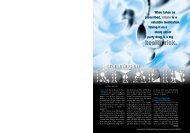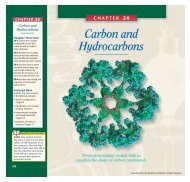You also want an ePaper? Increase the reach of your titles
YUMPU automatically turns print PDFs into web optimized ePapers that Google loves.
SECTION 9-2<br />
Visual Strategy<br />
Figure 9-8<br />
Point out that the fluid exerts<br />
pressure in all directions. Pressure<br />
against the sides of the box<br />
also increases <strong>with</strong> depth.<br />
Suppose the box in the dia-<br />
Q gram is immersed in water<br />
and L = 2.0 m. How does pressure<br />
on the box’s sides 1.0 m<br />
from its top compare <strong>with</strong> pressure<br />
on the sides near the top and<br />
near the bottom?<br />
∆P = rg∆h = (1.00 ×<br />
A<br />
328<br />
10 3 kg/m 3 )(9.81 m/s 2 )<br />
(1.0 m) = 9800 Pa. This means<br />
that the pressure on the middle<br />
area of the sides of the box is<br />
9800 Pa higher than the pressure<br />
near the top and 9800 Pa lower<br />
than the pressure near the bottom<br />
of the box.<br />
ANSWERS TO<br />
Conceptual Challenge<br />
1. The pressure inside the<br />
building is approximately<br />
equal to the pressure outside<br />
the building.<br />
2. The small piston must be<br />
pushed a long distance to<br />
move the object a short<br />
distance.<br />
3. With snowshoes, her weight<br />
is applied over a larger area,<br />
so the pressure is small.<br />
Without snowshoes, the force<br />
is applied over a smaller area,<br />
so the pressure is large.<br />
L<br />
328<br />
Chapter 9<br />
P0<br />
P0 + ρgh1<br />
P0 + ρgh2<br />
Figure 9-8<br />
The fluid pressure at the bottom of<br />
the box is greater than the fluid<br />
pressure at the top of the box.<br />
Pressure varies <strong>with</strong> depth in a fluid<br />
1. Atmospheric pressure Why doesn’t the<br />
roof of a building collapse under the tremendous<br />
pressure exerted by our atmosphere?<br />
2. Force and work In a hydraulic lift, which of<br />
the two pistons (large or small) moves through a<br />
longer distance while the hydraulic lift is lifting an<br />
object? (Hint: Remember that for an ideal machine,<br />
the input work equals the output work.)<br />
As a submarine dives deeper in the water, the pressure of the water against the<br />
hull of the submarine increases, and the resistance of the hull must be strong<br />
enough to <strong>with</strong>stand large pressures. Water pressure increases <strong>with</strong> depth<br />
because the water at a given depth must support the weight of the water above it.<br />
Imagine a small area on the hull of a submarine. The weight of the entire<br />
column of water above that area exerts a force on the area. The column of<br />
water has a volume equal to Ah, where A is the cross-sectional area of the column<br />
and h is its height. Hence the mass of this column of water is m = rV =<br />
rAh. Using the definitions of density and pressure, the pressure at this depth<br />
due to the weight of the column of water can be calculated as follows:<br />
F mg<br />
P = ⎯⎯ = ⎯⎯ = ⎯<br />
A A<br />
rVg<br />
rAhg<br />
⎯ = ⎯⎯ = rhg<br />
A A<br />
Note that this equation is valid only if the density is the same throughout the<br />
fluid.<br />
The pressure in the equation above is referred to as gauge pressure. It is not<br />
the total pressure at this depth because the atmosphere itself also exerts a pressure<br />
at the surface. Thus, the gauge pressure is actually the total pressure<br />
minus the atmospheric pressure. By using the symbol P 0 for the atmospheric<br />
pressure at the surface, we can express the total pressure, or absolute pressure,<br />
at a given depth in a fluid of uniform density r as follows:<br />
FLUID PRESSURE AS A FUNCTION OF DEPTH<br />
P = P 0 + rgh<br />
absolute pressure =<br />
atmospheric pressure + (density × free-fall acceleration × depth)<br />
This expression for pressure in a fluid can be used to help understand<br />
buoyant forces. Consider a rectangular box submerged in a container of water.<br />
The water pressure pushing down on the top of the box is −(P 0 + rgh 1), and<br />
3. Snowshoes A woman<br />
wearing snowshoes stands<br />
safely in the snow. If she<br />
removes her snowshoes,<br />
she quickly begins to<br />
sink. Explain what happens<br />
in terms of force<br />
and pressure.<br />
Copyright © by Holt, Rinehart and Winston. All rights reserved.
















